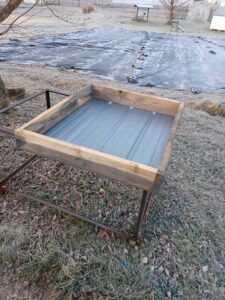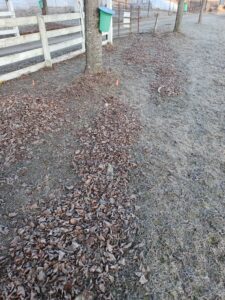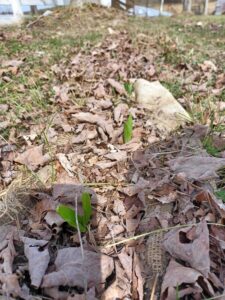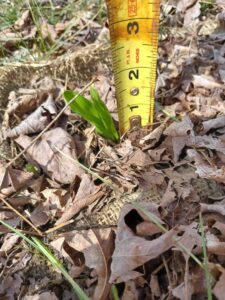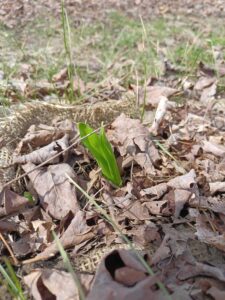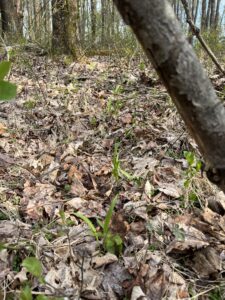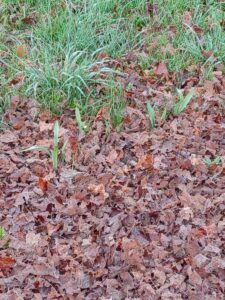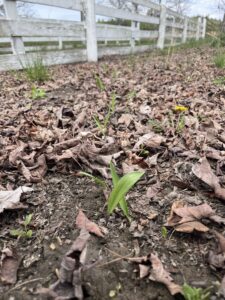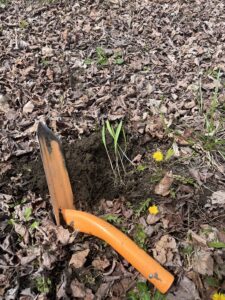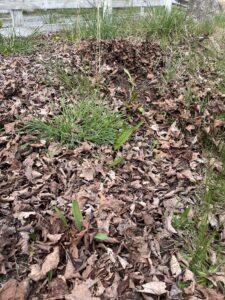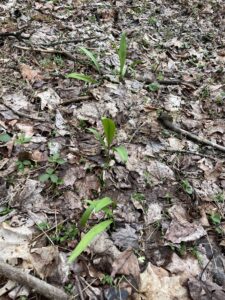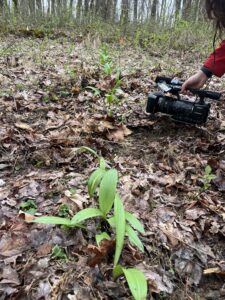Final report for ONE21-383
Project Information
Cultivating ramps and growing ramps at a commercial scale remains challenging and problematic. Researchers were unable to germinate ramps from seeds, and planting in rows using burlap to help with harvesting was ineffective. The newly germinated ramps, or ramplets, that were purchased as 'starter' crops can be grown profitably, depending on survivorship - which was largely dependent on being cultivated in a 'naturalized' setting. Larger transplant bulbs purchased at higher prices were not profitable at market prices. When considering all factors that go into ramp propagation, including the labor input to plant and harvest, as well as concerns over the number of growing seasons needed to reach maturity; makes large-scale adoption of the commercial production of ramps for sale unlikely. In fact, through the course of this grant cycle, the original Principal Investigator had transferred jobs to another college and our partner farm closed its operations; indicative of the many uncertainties and changes that will inevitably occur throughout the required time commitment and investment to grow ramps commercially.
For commercially sustainable ramp harvest options, the best course of action remains to harvest 10% from natural, or wild-simulated, reproducing patches on an annual basis. This will allow the ramp population to remain stable as they are perennial, cannot over-mature; and will continue to multiply, via bulb-splitting and seeding, without care and can be harvested as the market demands throughout a season.
Our project seeks to quantify potential return on investment of ramps as a specialty crop with multiple market entry and exit points for ramps that can be integrated with existing operations to create additional revenue opportunities. Our objectives will answer: can we develop a propagation and management model that can create an opportunity for farms to boost income? This partnership seeks to demonstrate a viable plan to create revenue that will encourage farms to add ramps to their portfolio of offerings, and in turn alleviate pressure on wild populations.
This project seeks to capture the labor and financial resources needed to prepare both ramp transplants and mature ramp bulbs for market. We compared seeding, planting from newly geminated ramp stock, and using transplant bulbs to to understand the return on investment (ROI) potential from each of these sources. These comparisons are intended to educate farmers on avenues to profitability in producing ramps. While this funding cycle is too short to evaluate all aspects of ramp production for market, this project will provide baseline financials to spur additional cooperative investment (grant or private dollars) for ramp cultivation.
Research suggests wild ramps are in decline (Baumflek and Chamberlain 2019), but the posts from West Virginia Ramp Diggers Facebook® group (especially since COVID-19) demonstrate a thriving demand for foraged ramps (and tips to establish ramps); with posts reflecting some yields in the hundreds of pounds and buyers looking to purchase in bulk. This represents an opportunity for West Virginia farms, which have the lowest average economic output of any state ($38,000), with ¾ of them selling less than $10,000 annually. There are 23,000 farms in WV averaging 157 acres, commonly relying on seasonal differentiation and niche markets (Christmas trees, maple syrup, asparagus, berries, medicinal herbs, cut flowers, mushrooms) to increase agricultural income.
Sprouting Farms was developed to grow the economic output of farms by providing technical advice and resources needed to create opportunities to grow the agriculture economy. Ramps are an ideal long-term investment to those enrolled in the beginning farmer training programs. They are perennial, cannot over-mature; and continue to multiply, via bulb-splitting and seeding, indefinitely. They can be part of a multi-stage agroforestry model that works over generations, and practices whole farm diversification as a pathway to sustainability in both good land stewardship and business practices. However, despite a consistent demand, there is no ‘start-up’ model for initiating ramp cultivation for commercial production. The distribution partner of SF, Turnrow has seen ramp demand outpace supply since first offering them in 2017. To facilitate adoption of ramps on farms, the partnership between WVU and SF will compare and document the start-up resources needed to produce nursery stock from seed and establishing mature ramp plots for harvest with transplant bulbs. Sprouting Farms is dedicated to the exploration of a sustainable supply of ramps to meet market demand and currently sees multiple market entry and exit points (transplant bulbs vs. greens vs. mature plants vs seed) that allow farmers options in establishing revenue-producing operations to serve the various markets for ramp production.
To educate farmers, this partnership will evaluate: 1) seed to nursery stock comparisons between a controlled environment (greenhouse) with direct seeding in forest plots, and 2) planting of nursery stock using a novel mechanized, forest planting technique meant to facilitate harvest. By demonstrating the ability to increase start-up efficiencies for entering a market via multiple entry points, we hoped to promote ramps as an ancillary income stream suitable for operations with standing timber. Our partnership will quantify differences in survival, growth, and labor reductions in cultivation techniques, broken down by these two stages (seed to nursery stock, transplant bulb to mature plant) to evaluate the effectiveness in terms of farm effort cost-efficiencies. The aim is to create opportunities for additional on-farm revenue and protect wild ramps in the future by cultivating an agricultural economic opportunity, as an alternative to regulation.
Cooperators
- - Producer
- (Educator)
Research
METHODS AS PROPOSED
The partnership with our innovative farming partner will enhance the methodologies used to cultivate ramps systematically and in a cost-effective manner. Sprouting Farms will integrate plantings within the space of existing operations, and be responsible for the long-term care of these crops. The ramp seeding and bulb transplanting densities and spacing will be based on Dion et al. (2016b) and ramp farmer Glen Facemire’s (2009) recommendations.
Preparation of Amended Ramp Soil for Propagation: To maximize the likelihood of successful ramp plantings (as well as other plantings), Sprouting Farms amends plantings by fertigating soil based on Korean Farming Techniques (Keliikuli et al. 2019) to develop micro-organisms likely to facilitate growth response in their plantings based on a symbiotic relationship. Preparations include collecting two, five-gallon buckets of leaf mold and soil base from a known productive, wild ramp patch and depositing them into a 55-gallon drum. Then, the SF team makes a potato starch concentrate from organically grown potatoes in a blender with water. The soil (microbe load) in the collected soil/leaf debris is then fed in the drum by combining it with the concentrate and topping off with water and mixing occasionally. After three weeks, the solution will be divided to fertigate ramp growing mediums with the solution. Five gallons will be applied over time during initial watering to the seed flats in greenhouses and seed beds prepared through direct seeding (equal volume for each treatment). Similarly, as transplant bulbs are set into forest plots, both the traditional and the mechanically assisted beds, the remaining 40 gallons of solution will be equally applied to both treatments initially to encourage microbial activity.
Seed to Nursery Stock Trials: The Partnership team between WVU and SF will cultivate the seeds in container flats, and direct seed into the soil under shade conditions with the intention to transplant bulbs after three years. Although density may vary by size of container, each container in a greenhouse is expected to hold 200 ramp seeds based on planting densities resulting in approximately 25 flats of ramp seed to bulb. Outdoor direct seeding will take place in demonstration areas under natural shade conditions. Seeds will be placed approximately ½-inch under the soil layer in plots marked with flagging and stakes. The 5,000 seeds planted outdoors are anticipated to be in a series of raised bed rows totaling around 100 linear feet with three rows of seeds planted in each bed for a total of 30 seeds planted per square foot. Seeding will be deliberate and counted for each plot, as Spring 2022 and Spring 2023 will require survival estimates of seeds based on leaf out; but no other morphological data on these ramps are collected for these first two sampling periods. In Spring of 2024, a total of 25% of the prepared beds will be dug up for comparison to a random sample of 25% of the bulbs grown in container plots. Samples will be weighed and evaluated for appropriate sizing to determine if the three-year cycle successfully enabled the growth of ramp transplants from seeds, and to evaluate any differences in bulb life-history attributed to the seed planting methodology.
Nursey Stock to Mature Plant Trials: Using the existing nursery stock cultivated by SF over the past two seasons, SF will follow two methodologies for planting transplant bulbs for mature harvest. One half of the transplant bulbs (approximately 85 plants) will be propagated in an agroforestry context featuring raised beds consisting of logs and leaf litter consistent with bed preparation described by Chamberlain et al. (2014). In brief, under the shade of deciduous trees, SF staff will make a series of low raised beds edged with lumber or logs and cover the soil with lots of well-rotted leaves. Transplants will be planted in these beds, and like seedlings, monitored during Spring of 2022 and 2023 for survival. These ‘traditionally’ planted ramp beds will be compared to an alternative planting featuring bulb bed preparation using a mechanized trencher to loosen and rip the ‘duff’ layer of soil on contoured rows within the forest instead of building up raised beds. These trenches will be approximately 6” wide and up to 8” deep and a strip of burlap will line the bottom and sides, forming a “U” in the trench before being backfilled and stocked with the other half of prepared nursery stock bulbs. To recap, these transplanted bulbs were selected for independent evaluation due to the long maturation process of these plants, and to an additional set of transferable results with regards to the ramp market during the funding cycle for this award. The burlap was added to determine if there might be any efficiencies associated with harvest of ramps in beds prepared in this manner.
Plots will be planted and tended by Sprouting Farms staff, as they will be responsible for quantifying the level of resources needed to develop and grow ramps in stages, as well the long-term management and care of these ramp patches after this funding expires. Trench end points will be plotted with GPS and marked with wood stakes. Colored line, representing treatments, will be stretched between rebar to visually represent plot treatments during data collection. Annual monitoring will require survival estimates based on leaf-out during Spring of 2022 and 2023, while similar to seed trials, 25% of ramps will be dug up on the last year of the funding cycle (2024) to evaluate any differences in growth vigor as well as year to year survival.
The measure of success will be in promoting visually stimulating results, audience engagement exploring ramp production opportunities, and showing the return on investment of the operation.
Fall 2021
In late fall of 2021, we received 6,000 seeds, 950 transplant bulbs, and 300 mature bulbs from Gates Hill Farm in Vermont. On November 16th, we planted 300 mature bulbs for non-consumptive evaluation, and 600 transplant bulbs with our partner, Sprouting Farms, in Talcott, WV. The remaining 350 transplant bulbs were planted at the WVU Research Forest two days after on November 18th.
The seeds were placed in cold storage, and then planted 5 to a group in greenhouse trays and placed outside anticipating a spring 2022 germination.
Doing some measuring before planting
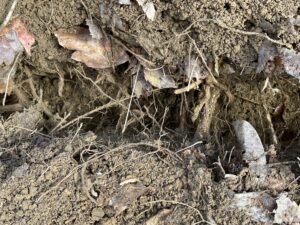
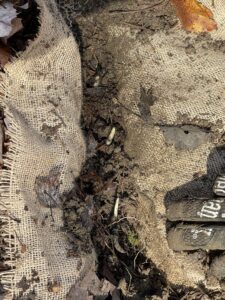
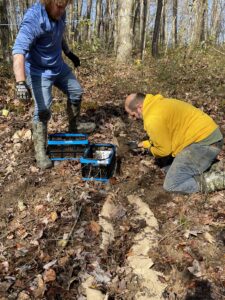
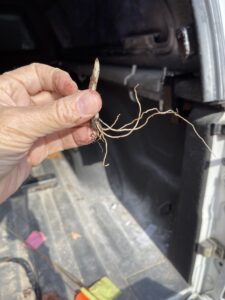
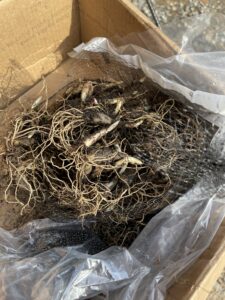
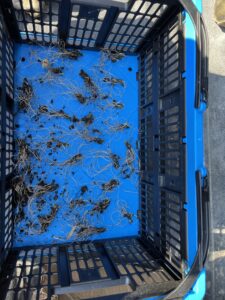
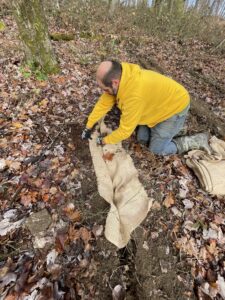
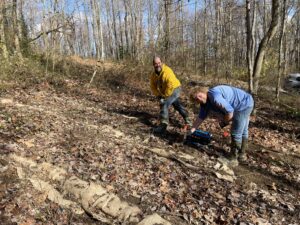
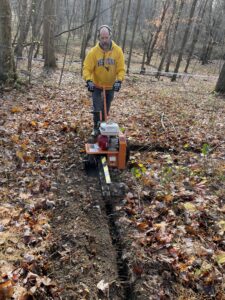
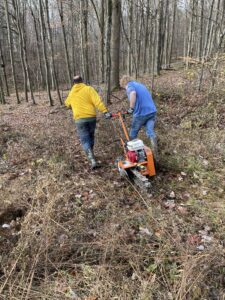
Germination tray at Sprouting Farms

Dormant ramp plant among maple trees at Sprouting Farm.
Spring 2022 Results
Ramps are known to be notoriously slow-growing and challenging to establish cultivated beds, especially considering they were planted the preceding fall. The prepared beds were not harvested, only observed to evaluate the survival of the two-year old bulbs and the 'ramplets'. Seeds were sown both in the ground, but also in prepared greenhouse trays. Based on visual estimates, the two-year old ramp transplants had a survival rate of approximately 85% , while ramplets were estimated to be approximately 65%. Seeds germination rate was abysmal. Annual monitoring results are tabulated below (Table 1) and will be updated annually up to harvest on 25% of the sample in Spring of 2024 to measure growth.
Monitoring Year 2022 Discussion
Results were disappointing - especially with regards to seeds - but not all together unexpected. The first year of cultivation of a traditionally grow 'wild' foraging crop was not expected to be easy. Two year transplant bulbs met general expectations, however the 'ramplets' survival were less than one would have hoped. As noted, seed germination was abysmal. Researchers called Devin Bachelder of Gates Hill Farm, who supplied our stocking. He suggested the ramplets may have been planted slightly too deep, but urged us not to give up hope on them or the seconds for the second year. He suggests that sometimes seeds will take up to two years to germinate, matching the literature. He considered his technique to get seeds to germinate en masse that enables him to see ramplets is intellectual property and gives his farm a competitive advantage. We are inclined to agree with him based on our results.
Two year old ramp transplants emerging in Spring of 2022
Spring 2023 Results
Spring 2023 results were similar as 2022 with respect to survival and the lack of progress from ramp seeds (Table 1). This was hugely disappointing but as noted earlier as a 'farmers' secret' that we have not solved with this project. However, the ramplets are demonstrating promise in terms of survival and the planting technique in 'bunches' that will allow for improved harvest. Our partners at Sprouting Farms experienced similar results with seeds, and although their ramps were planted in less of a woodlot, they continued to thrive early spring.
Woodlot and Sprouting Farm ramplet bulbs planted in bunches showing promise of future harvest.
Spring 2024 Results
Spring 2024 results had diminished survival from previous years (Table 1). No ramps resulted from planting from seed. Approximately 25% of the bulbs were dug up, brushed free of dirt and debris, and weighed. Both plantings of ramps located at the WVU woodlot (sugar maple stand) increased in weight more than at Sprouting Farms. This was likely due to the poor planting location at Sprouting Farms. It should also be noted that our sampling event (April 8th) at Sprouting Farms occurred during the last week it was open. Unfortunately, the following week Sprouting Farms was shuttered and has not reopened since, despite the closure being called 'temporary'.
Photos of the ramp patch at Sprouting Farms, including 'ramplets' dug up for weighing.
The plantings at the WVU Woodlot faired better than Sprouting Farms, likely due to their location in a 'naturalized' environment. During the samping event on 18th of April, we invited the local press (WBOY) to do a story for the evening news and online audience. The story aired twice on April 26th, reaching over 15,000 households or equating to some estimated 36,000 people.
Ramps from the WVU Woodlot sugar maple demonstration area, in a naturalized setting. Of note, the burlap laid in the trench to facilitate harvest has disintegrated and did not provide any utility in the harvest. However, the act of trenching the soil prior to planting cleared the soil of socks and roots - making the harvest easier than typically encountered than when digging 'wild' ramps.
Table 1. Survival estimates
| Weights | Survival Estimate | ||||||||
| Location | Description of Planting | Number Planted | Price per Unit | Average weight (grams) at Project Start | Average weight (grams) at Project End | Weight Increase | Year 1 (2022) | Year 2 (2023) | Year 3 (2024) |
| Sprouting Farms | Two-year old ramp bulbs | 250 | $0.77 | 1.055 | 5.74 | 544% | 85% | 80% | 60% |
| Ramplets | 600 | $0.33 | 0.212 | 0.878 | 414% | 65% | 60% | 40% | |
| Seeds | ~3000 | $0.03 | - | - | - | <1% | <1% | 0% | |
| WVU Forest | Two-year old ramp bulbs | 150 | $0.77 | 1.0536 | 6.02 | 571% | 85% | 85% | 80% |
| Ramplets | 400 | $0.33 | 0.22 | 1.16 | 527% | 65% | 65% | 65% | |
| Seeds | ~1500 | $0.03 | - | - | - | <1% | <1% | 0% | |
Our research is on-going, we can say that the germination of seeds consistently could be considered a 'farmer's secret.' Based on the survival and current market pricing for ramps, we generated the following Return on Investments in each planting setting.
| Financials | ||||||||
| Location | Description of Planting | Number Planted | Price per Unit | Average weight per lot | Initial Seed Investment | Estimated Population at Project End | Estimated Sales Value ($25 per pound [~50 total] for mature. $0.77 for transplants) | ROI |
| Sprouting Farms | Two-year old ramp bulbs | 250 | $0.77 | 5.275 | $192.50 | 150 | $ 75.00 | -61% |
| Ramplets | 600 | $0.33 | 1.06 | $198.00 | 240 | $ 184.80 | -7% | |
| Seeds | ~3000 | $0.03 | - | 0 | 0 | |||
| WVU Forest | Two-year old ramp bulbs | 150 | $0.77 | 5.268 | $115.50 | 120 | $ 60.00 | -48% |
| Ramplets | 400 | $0.33 | 1.1 | $132.00 | 260 | $ 200.20 | 52% | |
| Seeds | ~1500 | $0.03 | - | 0 | 0 | |||
Based on the survival percents and weight gain on ramps, planting ramps in a naturalized environment is preferred and yields better results than a traditional agricultural setting. Our research does not support the growing of ramps from seed as a cost-effective practice. We objectively failed on every level of this and attempt at this, and succumb to not figuring out the 'secret sauce' of Gates Hill Farm. Anecdotally the Gates Hill Farm, located in Vermont, leases the 'ramp' rights from landowners to harvest seeds for propagation. They can propagate these seeds en masse to sell as the ramplets. We could not replicate these results.
Moreover, the 'ramplets' grew to the approximate size of the transplant bulbs throughout the period of this grant. As such, we used the price of the transplant bulbs ($0.77 cents each) to estimate the return on investment (ROI) based on the survival. The ROI of the transplant bulbs was based on the $25 / pound price for mature ramps, and we estimated approximately 50 of these bulbs per pound based on weight.
The return on investment is largely based on the survival rates of the original planting stock. With such a short grant timeline relative to the entire life cycle of a ramp, three years of grant funding compared to seven years it takes a ramp to grow to seed-producing maturity, determining the most profitable way to cultivate and harvest ramps was problematic. Starting a ramp patch from purchased stock with the intention to cultivate and sell for profit was more challenging than anticipated. There are no labor savings to be gained from planting with burlap. While it was possible to profit by planting ramplets in a naturalized setting and harvesting for transplant bulbs after three years, the ROI was 52% over three years or about 17.3% annually. However, because ramps are long-lived, these gains must be balanced by concerns over growing disruptions that result from herbivory, drought, or invasive competition.
Education & Outreach Activities and Participation Summary
Participation Summary:
Before closing, Sprouting Farm's onsite program participants include aspiring and beginning farmers, area schools, colleges, workforce programs, veterans to agriculture programs, and workforce development centers. Through general community events, over 500 visitors have witnessed and learned about Sprouting Farms cultivation annually. The following is a link to the distributed ListServe that educated other producers on the planting and status of the project. This link was distributed to 400 regional farmers and producers. In addition, Sprouting Farm highlighted some of the ramp work on social media (Facebook) to promote plantings in Spring 2024.
PDF: Ramp-ing Up Production!
Link: https://mailchi.mp/e3323c334abc/ramp-ing-up-production?e=%5bUNIQID%5d
Our outreach is featured in WVU Extension landowner clinics to promote the applied techniques and emerging ramp markets. Additionally, we were featured on local news; resulting in approximately 35,000 individuals learning about ramp scarcity and ways to reduce pressures on native populations. This story has been archived and will likely be rerun during next springs (2025) ramp harvest season.
Learning Outcomes
Woodlot owners were cautiously optimistic at the ease of planting and harvesting, but are still unlikely to scale and wholly adopt this process due to the potential for low margins on any realized profits. However, woodlot owners will likely continue to cultivate and harvest from any naturalized patches of ramps already occurring on their property.
Project Outcomes
Currently Sprouting Farms staff are optimistic these methods will yield ramps for harvest with reduced labor needs. However, much has been learned about the planting and if done again, Sprouting Farms would have opted to place the ramps in more of a wooded area despite the growing success. Most important aspect of this is realizing that the 'sweet spot' for producer may be in the production of ramps from ramplets; not in the production of seeds or growing from seeds - nor growing from two-year old transplants.
The ramp patch placed in the dedicated ‘sugarbush’ for maple syrup faired better than the artificial planting on the farm. Sugarbush provides access (ATV trails, maintenance trails for tubes) to ramps in a naturalized setting and seasonally timed to follow maple syrup season. In hindsight, the farm approached was challenged by both internal farm logistics associated with changes in ownership and placement near dedicated annual crop fields was not optimal since ramps do not need tending like these annual crops.
Although the use of burlap bags to facilitate harvesting was unsuccessful due to decomposition – the mechanized trenching to used to prepare beds and plant ‘ramplets’ did result in easier harvesting. This was a result of the absence of rocks and roots resulting from the 6”- 8” deep process. Further areas of study should focus on the germination of ramp seeds as it is possible as demonstrated by the Gates Hill Farm (www.rampfarm.com) in Vermont, who sourced the seeds, ramplets, and transplant bulbs for this project.

